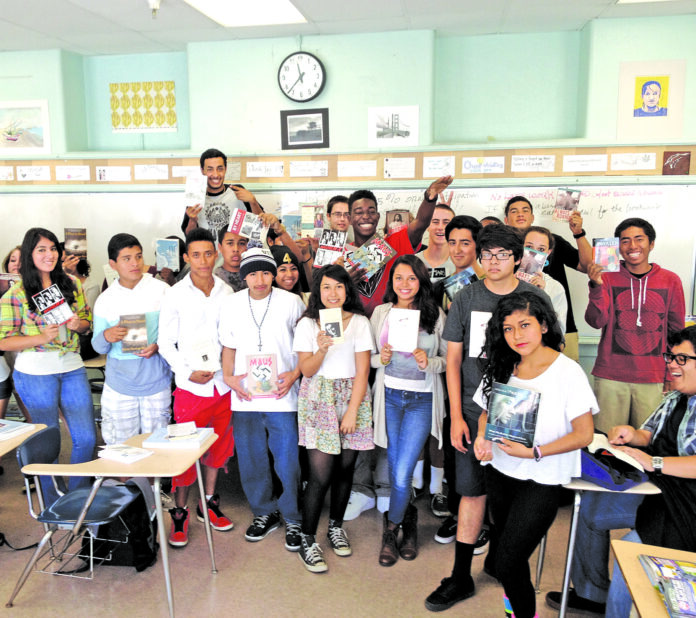
Having recently learned about the Culver City High School chapter of POPS, a club whose mission “is to help kids whose loved ones are incarcerated and provide a safe space for them at their local schools,” we wanted to find out more so we reached out to the organization, and a local student named Alba Navas. “Culver City is very different from many other schools,” Navas said. “It’s very diverse, not only in race but on socioeconomic level as well. POPS has been a direct source of intersectionality. This has made POPS truly show its power because it has connected many different kinds of students.” Ambassadors from the organization discussed the hardships that children with incarcerated loved ones endure in school and elsewhere. “Because of the stigma attached to incarceration, children are often perceived by teachers and administrators as potential prisoners themselves, treated as if they are not worth expending time and energy on because they will only fail,” they said. “In addition, frequently other students and their parents look down upon those with incarcerated family members. Because of the stigma so frequently attached, they may keep silent about their needs. Visiting a loved one in prison is challenging–long travel times, passive abuse by prison guards, sometimes lockdowns in prisons happening suddenly and visits canceled (as during the pandemic when there were no prison visits permitted). Sometimes those in prison insist that their children not let anyone know about the family situation (“it’s no one’s business”) and so kids are forced to keep a large secret–even from best friends. Frequently when a parent is locked up, the family suffers a family breakdown; a child may wish to visit his or her father, for instance, and the mother may not permit that, so ties are weakened and sometimes lost.” There are many misconceptions that the public has about people in prison and their families. “The primary misconception is that because of having a loved one incarcerated that young person is likely to be incarcerated too,” they said. “Absolutely not true and that misconception IS the stigma. People expecting the worst of a young person puts that individual in an impossible bind: How to prove the expectation wrong while feeling burdened by that expectation? Other misconceptions include that the person cannot possibly love “the bad guy” (the incarcerated individual) without there being something wrong with them; that they must themselves be “bad guys”; that there is something inherently wrong with the family itself; that they cannot be successful, cannot shine in school and beyond, cannot compete intellectually, emotionally or socially with kids who aren’t impacted by incarceration.” POPS helps kids use writing and artwork as a rehabilitation tool. “The anthologies are tools for rehabilitation in this way,” the ambassadors said. “Often children are loath to tell their parents or siblings or other loved ones about the real impact of the incarceration on that child. They do not want to add to the stress of their incarcerated loved one, and they fear that telling the truth about what happens to them “outside” will increase that stress. They often feel protective and/or sometimes they are estranged from their incarcerated loved one and cannot share their feelings with that person–though they might “secretly” wish they could. Telling the story on the page provides an outlet, a kind of healing, and an opportunity that somewhere down the road someone’s father or mother or sister or brother will read that piece and it will strike a personal chord. POPS has heard from many incarcerated individuals (and works with other nonprofits that support currently and formerly incarcerated individuals) and they have told us that reading a story or poem by a young person they don’t know helped them to better understand their own child or sibling and helped them to foster a stronger relationship with that individual. Also, in terms of rehabilitation, it cements the desire to do well, to be free, to reconnect with family on a deeper level.” And it works! POPS sees changes in the participating children. “We see kids who were ready to drop out suddenly seeing themselves with bright futures, and planning to go on to college, and then doing so; we see kids give up gang life for art; we see kids become less depressed and less anxious,” they said. “We’ve had kids tell us that years of therapy didn’t help them the way one POPS meeting did. We see kids connecting with people they might never connect with outside of POPS–mixing among kids of different genders, ages, races and socio-economic status in ways they do not out in the hallways. We’ve seen kids who have themselves done time begin to feel part of a community–one that supports their education, their health, their connection to friends and to teachers. The kids take surveys twice a year, and they report changes like those above and many more including a deeper connection to their own families, to their friends, to their artistic selves and to their communities.” Finally, Navas said that there has been a supportive response from teachers. “So much so that they will directly recommend POPS to students,” Navas said. “Many teachers were very happy to see that POPS was back in person this year. Like in other schools, POPS also has this special environment where kids just open up about what’s bothering them and what’s on their mind. There has been an outpouring of support inside and outside of the club.” For more info, visit popsclub.org.
